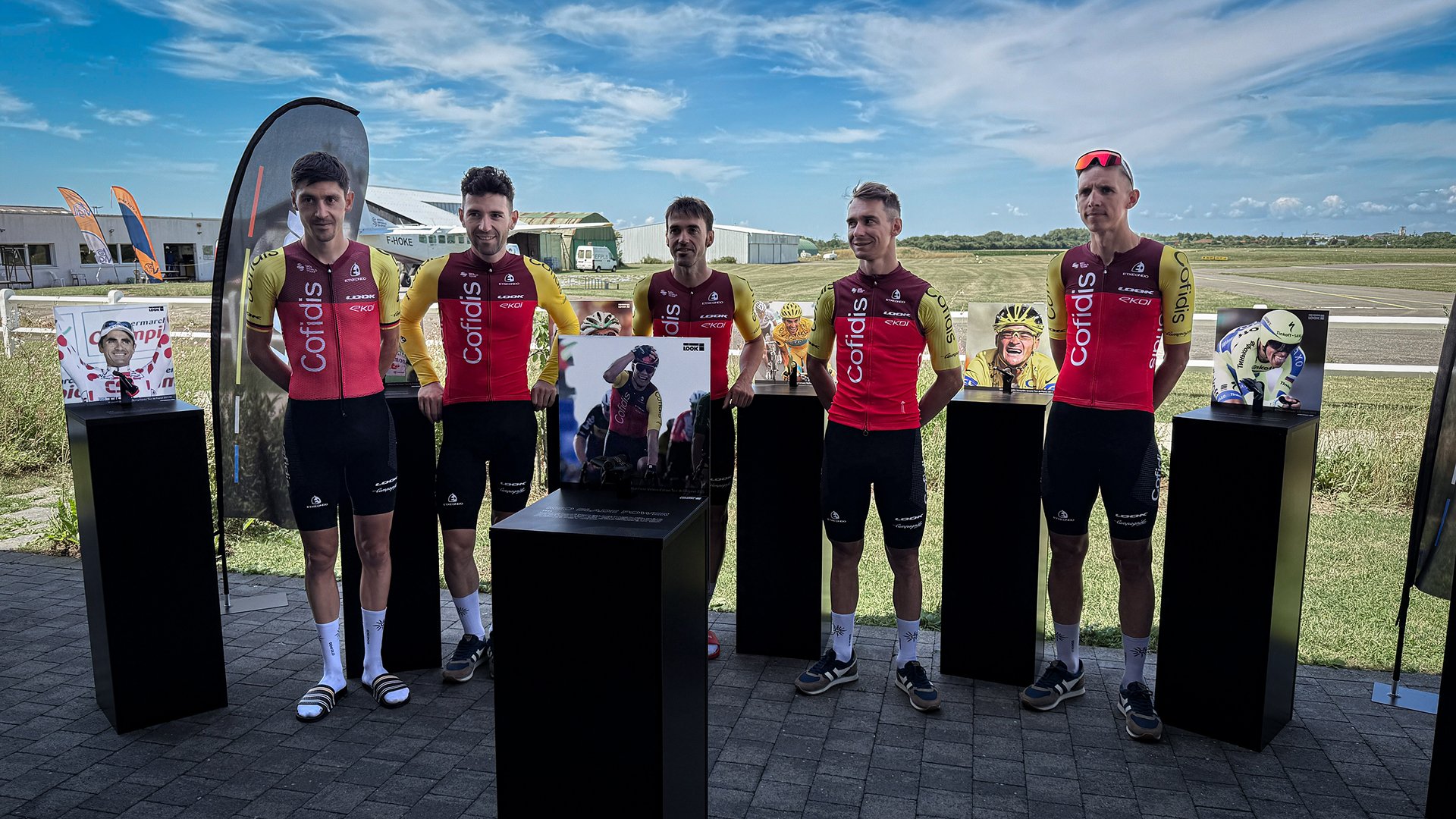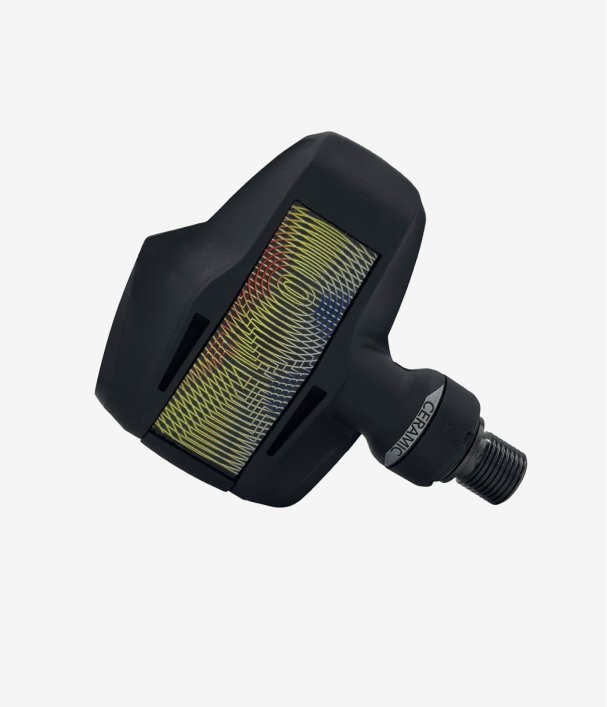40 Years Of Science Meets Art

LOOK Cycle has been at the forefront of cycling innovation since 1985. The French brand has created epoch-making products that increase safety, lower drag and crank up enjoyment, all with a certain sprinkling of panache…
“Pioneering spirit.” “Pushing the boundaries of performance.” “An artist’s aesthetic”. Every cyclist has a view on what makes LOOK Cycle an iconic high-performance brand, but uniting all is that LOOK continually evolves and innovates in search of the most memorable riding experience possible. In seeking out the “perfect ride”, there have been many product and racing standouts over the past 40 years. Here, we chart the highlights, beginning in a hospital ward 74 years ago…
Broken beginnings
LOOK Cycle was actually founded in 1951 in Nevers, a commune in France built on iron and steel, shoes and fur. Keen skier Jean Beyl broke his leg and blamed the severity of his injury on his antiquated skiing footwear. There must be a better way, he thought. And there was, Beyl inventing a plated ski binding that would ultimately change the face of skiing and cycling. In 1985, two years after the flamboyant Bernard Tapie took the helm, LOOK Cycle applied that spring-loaded binding technology to the bicycle market, inventing the world’s first clipless pedal.
“The PP65 pedals would ultimately cause a revolution in cycling,” says Sébastien Coué, international sales marketing director at LOOK Cycle. “They also helped Bernard Hinault to his record-equalling fifth Tour de France title in 1985. Long-time fans of the sport will remember the bloodied affair of Saint Etienne.…”
More specifically, stage 14 into Saint Etienne. The peloton launched a sprint; Hinault went down. The Frenchman suffered a double nose fracture and a slash across his scalp, forging the iconic image of the Breton riding to the line, his visage concealed by blood.
“I still have both legs and both arms,” the bruised Badger commented afterwards. “Without the PP65, the crash would have been much worse and I wouldn’t be able to start tomorrow. It’s the most important technological development of the last 30 years.”
Which was soon followed by another. “In 1986, we created the world’s first carbon frame, the KG 86, which was assembled by hand, the carbon tubes connected via aluminium lugs,” says Coué. LOOK Cycle’s group of engineers had worked tirelessly on a secret project that saw the light of day at that year’s Tour where, in an historic encounter, Greg LeMond and his La Vie Claire teammate Hinault rode the KG 86 to first and second, respectively.
“This revolution, first with the pedals and then with the carbon bike, led to what I call ‘adoption’ as over the next few years clipless became the dominant system in the peloton,” says Coué. Carbon-fibre bikes took a little longer to become omnipresent. But it happened, 1998 being the last time a carbon-fibre bike did not win the Tour de France.
Precursor to popularity of power
Another less-heralded LOOK Cycle’s innovation happened in 1990, as the LOOK Max One, which measured wattage at the hub, laid the foundations for the power revolution that would sweep over professional and amateur riders alike. “In the years to come, we will all need this dashboard of information,” French professional Pascal Poisson said at the time. “LOOK Cycle integrates power functions that take into account the wattage we generate. This will allow us to use a gear ratio better suited to effort for superior performance.”
“It was certainly ahead of the game and even generated data that featured on televised coverage of that Tour,” adds Coué. “Forward to the present and that groundbreaking spirit is seen with the LOOK Keo Blade Power, which is the only pedal-based power product in the men’s WorldTour, used by the likes of Bryan Coquard, Alex Aranburu, Milan Fretin and Emanuel Buchmann at Team Cofidis. It’s really quite an achievement – a tour de force, you might say – to integrate all the electronics within the pedal axle and consistently deliver accurate results.”
In 1990, LOOK Cycle also joined the aerodynamic arms race with the KG 196. This was a frame of firsts: LOOK Cycle’s first monocoque carbon frame, first integrated fork and first adjustable stem. LOOK Cycle’s pioneering engineers and R&D team, based in Nevers, had forged a true history-maker thanks to a manufacturing process whereby you create a carbon frame in one mould. The result? Increased rigidity, comfort and the capability to produce a variety of shapes – key to the slipstreaming evolution.
Victory after victory
The 1990s saw a series of further LOOK Cycle advancements, highlights including the PP 286 pedals, offering greater adjustment for greater comfort; and a new carbon frame in the form of the KG 171, which racked up a series of high-profile victories. As a snapshot, the KG 171 projected Luc Leblanc to the rainbow jersey in 1994 and provided the groundwork for Laurent Jalabert’s annus mirabilis in 1995 when he won 23 times, including La Flèche Wallonne, Milan-San Remo, Paris-Nice and the Vuelta a Espana.
Leblanc and Jalabert contributed to LOOK Cycle’s unprecedented success, a burgeoning palmares that features 34 GrandTour triumphs: seven titles apiece at the Tour de France and Vuelta a Espana, plus 20 wins at the Giro d’Italia.
That’s purely on the men’s side. LOOK Cycle has evolved alongside women’s cycling, supplying the world’s best with pedals and bikes for 40 years. Arguably, LOOK Cycle’s earliest high-profile success on the women’s side came in 1990 when French star Catherine Marsal won the world road race championships using LOOK pedals. Marsal also won the Giro d’Italia Femminile and the Tour of the ECC Women that same year, which was a precursor to today’s Tour de France avec Zwift. In 40 years, LOOK Cycle and its riders have enjoyed 11,000 professional wins.
It comes as no surprise, then, that the 2000s mirrored the 1990s with victories and innovations galore. “That’s when we moved from an aluminium to a carbon body with pedals like the CX7, our pedals really evolving from safety to performance,” says Coué. “You could also bring your foot as close to the axis as possible (Q Factor) for optimum performance, and change the angle of travel and tension adjustment, again for more proficient pedalling.”
Keo makes its debut
The carbon evolution of the early 2000s cranked up to revolutionary levels with 2004’s launch of LOOK’s timeless Keo that hit the scales at just 95g a pedal with a titanium axle. Soon after, Robbie McEwen, Simon Gerrans and Cadel Evans were raising their arms in victorious salute to LOOK Cycle’s cutting-edge technology.
As was Thor Hushovd, whose pedals dressed his LOOK 595, which hit the market in 2006. The integrated ‘E-Post’ delivered stability and comfort that ultimately combined for an extremely fast ride, the great Norwegian and the 595 reigning supreme over several stages of the Tour de France.
By now, the ‘Mondrian-inspired’ brand had cemented their reputation as craftsmen and women with unmatched pioneering spirit, earning the Trophee INPI for innovation for the second time. LOOK Cycle also won the IF Design Awards in 2010 for a pedal that again transformed the riding experience of cyclists all over the world.
“As we moved into the 2010s, we launched the Keo Blade, replacing the metal spring with carbon-blade technology,” says Coué. The result was a pedal that allowed a faster clip-out and a superior sense of retention, while weighing 20% less than the traditional system. “We also really focused on improving power transfer. That meant more contact between the cleats, the shoe and the pedals. That was the beginning of thinner, lighter pedals but with a larger contact point. Both Alberto Contador and Peter Sagan enjoyed remarkable success with those.”
Trickle-down from the track
LOOK Cycle’s confidence in its ingenuity is seen in its patents, of which there were 11 on the aesthetic wonder that is the 795 Aerolight. “Arguably, this was the catalyst for the ‘cleanness’ of bikes that you see today,” says Coué. “It featured integrated seatpost, integrated carbon stem, front brakes integrated in the fork, plus a monocoque carbon crankset.”
Velodrome fans noticed it had echoes of LOOK’s L96, which won 13 Olympic and Paralympic medals at London 2012. It was no coincidence. LOOK Cycle has enjoyed great track success on the track thanks to a long-time collaboration with the French federation, resulting in numerous medals for the likes of Francois Pervis, Grégory Baugé and Mathilde Gros. At the 2024 Paris Games, Benjamin Thomas won gold in the omnium aboard the LOOK P24, featuring such innovations as a double seatpost and wide-stance fork. LOOK Cycle takes these learnings and researches what could benefit the enjoyment of a wider riding audience.
“For us, the Olympics is like Formula One,” says Coué. “We learn a lot developing these bikes that we can then trickle down to the road. When milliseconds are the difference between victory and defeat, you really learn a lot about aerodynamics and power transfer.”
Of course, LOOK Cycle in 2024 isn’t all about the road and track. All genres of cycling are catered for, especially since 2016, aka the year of diversification. “We’d branched out to mountain biking a little before then, but that was when we really started to cater for commuters, too,” says Coué. Coué is being modest. LOOK Cycle has made great waves in the world of mountain biking for many years with its LOOK MTB pedals, which have projected the likes of Pauline Ferrand-Prevot to MTB world glory, while just this year LOOK-using Evie Alice Richards became the most successful XCC elite female rider in World Cup history with a dominant win in Brazil. Back to Coué… “That grew to gravel riders and even indoor cycling. Every pedal is specific. Take the indoor model as an example. It has an extraordinarily strong spindle to stand up to the demands of high-intensity indoor efforts.”
What of the 2020s? Well, LOOK Cycle has recently created its 10-millionth pedal, many of which have been used by recreational riders all around the world, whether it’s for an urban sojourn to the local café or taming Alpe d’Huez at L’Etape du Tour. LOOK Cycle has also continued to arm the peak of the performance pyramid, with Tadej Pogacar and Biniam Girmay riding their way into Tour de France folklore. It’s the same in the women’s peloton. In 2022, Annemiek van Vleuten became the first winner of the Tour de France avec Zwift, while Team Cofidis’ Victoire Berteau won the French national title in 2023. Both were using LOOK pedals. The victories continued in 2024 when LOOK Cycle launched their latest evolution of the Keo Blade marrying aesthetics and aerodynamics for the ultimate pedal.
But, what of the future? “We will continue to innovate and satisfy the needs of passionate riders,” says Coué. “We continue to focus on our bikes and pedals, and increasingly so on gravel, which is so popular these days. And we will continue to research and develop from our HQ in Nevers. We’re proud to have our own Factory at LOOK Cycle and proud of our committed industry-leading workforce. Here’s to another 40 years of innovation.”

Keo Blade Ceramic Ti
40 Years Special Edition
To celebrate 40 years of cycling innovation and passion, LOOK unveils the Keo Blade Ceramic Ti 40 Years Special Edition — a collector’s edition of its legendary pedal. Weighing just 95 grams and featuring a carbon body, titanium axle, and ceramic bearings, it embodies cutting-edge engineering for elite performance.
Its exclusive highlight? A uniquely designed blade crafted especially for this anniversary — a tribute to the brand’s heritage and racing spirit.
Whether you’re chasing podiums or a collector at heart, this special edition combines advanced technology with commemorative design. A rare piece that honors the past while powering cyclists into the future.